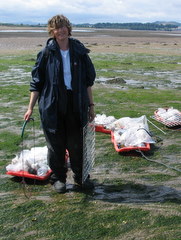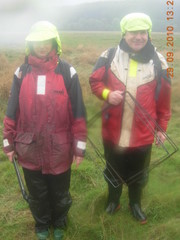Crikey… where do I begin? I knew it had been a while since my last blog but I hadn’t realised that it was 4 months ago!! Where has the summer gone??
It has been a hectic time. The SEPA marine ecology survey season has been based on a geographical approach to Scotland, so the rocky shore macroalgal (seaweed) surveys have taken place in waterbodies that lie in the South West geographical region of Scotland. These have included Loch Sween, the Inner part of the Clyde(around Dunoon-Kilcreggan area) and the Solway. As mentioned previously the data gathered is put towards a report on the quality of the waterbody for the EU Water Framework Directive (WFD), so its important work and not just a great excuse to be on the rocky shore!
I really enjoyed those surveys because we were rummaging around the rocks and pools trying to find as many types of seaweed as possible and then identifying them. The most I found and identified on one shore was 42 species. It might not be as many as the experts that I was working with, but I was quite pleased with myself and as everyone should know 42 is the answer to life, the universe and everything!!
Each area we surveyed was different, so I’ve had a really good introduction to Scotland and its biodiversity. I anticipated that some of the west coast countryside would be stunning and picturesque, such as at Loch Sween, but I had not expected places like the Inner Clyde area to surprise me with its beauty. There are some fantastic views across to mountains and lochs that I did not know existed. The surveys have also given me an introduction to the various types of rocky shores that make up the Scottish coastline.
However it did rather depend on the weather and midge population at the time as to whether it felt like a good or bad experience! Oh those pesky midges, I never really found anything that got ’em. I did however get given lots of advice for next year, but let us hope we have to survey in a different area.
Other surveys include a Macro Algal Blooming (MAB) survey on the Eden estuary outside St Andrews. We got there just after the golf tournament so the town was a bit quieter than the previous week. Certain types of seaweed can bloom in the presence of extra nutrients in the water. These are called opportunistic macroalgae. The SEPA method of surveying the extent of the bloom is to map it, with a handheld GPS unit, and take samples of each area that is covered by seaweed to determine the percent cover and biomass. This means that a team has to walk in pairs through the mud, water and weed of the estuary (at low tide) in order to gather this information.
I did not get on very well with this survey. I found it really hard physically and ended up hurting my ankle somehow which didn’t help. I also found I got completely disorientated in the estuary so when my working partner said “We need to go this way”, I thought “Haven’t we already done that?!”.
Samples are collected at random points and these are loaded up onto sledges, therefore we looked (and felt) like Antarctic explorers as we dragged the sledges behind us battling through the mud. Sledges are also very useful when the mud got a bit wetter and make you sink a bit. Your natural reaction when that happens is to stop walking and panic but I still have Susan’s voice ringing in my ears…”Don’t stop….Keep going” or “Jump on the sledge!”.

The last survey I did at the end of September was one looking at the quality of saltmarsh habitat in the southwest of Scotland on the estuary of the Nith at Dumfries. The Marine ecology team at SEPA are in the process of investigating how to define and classify salt marshes, so they can also be used as a bio-indicator of waterbody quality under the EU WFD.
I enjoyed this survey too. It was a good opportunity to learn what an important habitat salt marshes are. I love to learn about new species so it was a good chance to develop my identification skills of halophytic plants (ones that have adapted to saline conditions). It was quite difficult to move around the marsh, because as the saltmarsh extends, it builds up areas of vegetation that are higher and therefore are less inundated by the tide. These areas are crisscrossed by parts that have not developed so high, so you have to keep your wits about you to avoid the crevices! One thing we could not avoid was the weather and on the second day it poured down all day. I had borrowed some waterproofs but found out quite early on that they ‘werr’na verry waterr prroof'(as they may say up here).

Apologies to Steve Nowacki for inclusion in the blog, I thought I get this in first before anyone else does!!
That just about wraps up the SEPA survey stuff.
I’ve also done some BTCV work too. Unfortunately I missed the Uist BioBlitz due to clash with survey work but did attend the Ayr BioBlitz that took place on the 1st August in Ardrossan. I was suffering from a painful ankle (as mentioned previously on the MAB survey) so did not get about as much as I wanted. However I had a team and we went to look for seaweeds in the area designated to us. We did not find very many species, so my team members went to help with other apprentices who were bird spotting or catching bugs. It was a good chance to catch up with the other apprentices and see how they were getting on. Please remind me that if someone suggests we sleep on the floor of the civic centre again to… JUST SAY NO!! We got treated to a big fried breakfast the following morning which was much appreciated, thanks John.
A few days later Melissa (Mollusc Apprentice) and I helped out with other BTCV staff at the Big on the Beach event that was organised by Irvine Bay Regeneration Co and North Ayrshire Council and held at South Beach Ardrossan. We had a big tray full of species found in local rockpools, so spent the day explaining what creatures we had and how they survived in the intertidal habitat. Most children were really fascinated with the creatures and hopefully we have sparked an interest for the natural environment within them, so they begin looking after what is on their doorstep. It was exhausting but fun!
Another part of my time through the summer was concerned with gathering information for the second part of my apprenticeship, which is to assist SEPA with their Citizen Science programme. Although SEPA carry out a lot of important monitoring work they are very eager to engage with the public more. An opportunity to encourage the public to get out onto rocky shores and take part in the observation and recording of seaweed (macroalgae) for SEPA is envisaged with the Littoral Seaweed Project.
In order to gain an insight into what is available for the public to get involved on local shores I spent some time with a local authority ranger on a rock pooling session just outside Aberdeen and have taken part in two training days with The Shore Thing project. Another excuse to go out and spend time on the rocky shores!! Actually it was really beneficial to spend some time with different organisations, looking at how they interact with the public and how they get their message across. Thanks to Rob and Fiona for their time.
I did manage a bit of a holiday in October and did a ‘Great Trek South’ to catch up with friends and family, which was lovely. I picked up some of my warm winter kit too, as being a southern fairy, I am not looking forward to my first Aberdeen winter.
I’ve also recently had some training days including Project Management and the First Aid at Work course in Stirling. Get as much as you can when you can, as they say.
I think that just about brings me up to date. Winter will be working mostly indoors on data management and helping with the Citizen Science programme. I may even get time to write a blog more often.
Bye for now
Ruth
updat 24th Nov – We had our first snow yesterday, its going to be such a long winter
